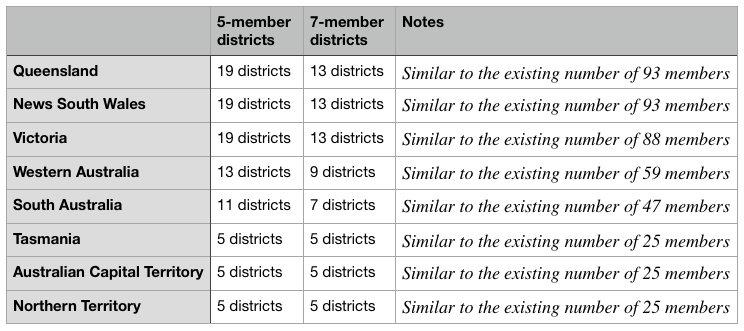The following text describes how our electoral system principles and design elements can be be applied to the electoral systems for State and Territory Legislative Assemblies (or Houses of Assembly):
Summary: State & Territory Legislative Assemblies (or Houses of Assembly) should be directly elected using multi-member electoral districts and the single transferable vote form of proportional representation, with no exclusionary threshold applying. The voting and counting systems should closely resemble the Hare-Clark systems used in Tasmania and the Australian Capital Territory, but with the transfer values described below.
Assembly structure: The Assembly should consist of an odd number of members. The Speaker should have a deliberative vote only. Where the voting is equal the question should be determined in the negative.
Multi-member electoral districts: Members should be elected from multi-member districts. Each district should return an odd number of members, either five or seven. Each district should elect the same number of members, and each member should represent the same number of electors, its ratio of electors to members should be within a range of plus or minus ten per cent of the Assembly’s average enrolment per member.
Neutral ballot-paper format: The ballot paper format should as clear and simple as practicable, similar to the ballot papers used for the Tasmanian Legislative Assembly. A ballot paper statement should advise electors to mark at least as many preferences as there are vacancies, and encourage them to mark further preferences, but a ballot should be considered formal if it is marked with a unique first preference. Candidates should be listed in columns, with the names of candidates rotated in different positions within each column, using Robson Rotation. Ideally, Robson Rotation should also apply to the order of the columns from left to right across the ballot paper.
One vote, one value: In the rules for counting votes, transfer values should be determined using the Weighted Inclusive Gregory Transfer method presently used for the transfer of surplus votes for Western Australia’s Legislative Council; or the Meek method prescribed in Schedule 1A of New Zealand’s Local Electoral Regulations 2001.
Direct election of all members: Casual vacancies should be filled using the countback system, with Tasmania’s contingency provision for a by-election poll if necessary.
Discussion
Compared with existing electoral systems for State and Territory Legislative Assemblies (or Houses of Assembly), the above policy proposes the following changes:
- Change from 1-member districts to multi-member districts, to deliver a far more proportional and representative result
- Use countback to fill casual vacancies, to ensure all representatives are elected by the preferences of voters
- Use fully optional preferential voting, to provide maximum flexibility to voters to indicate their preferences
- Use Robson Rotation within columns and for the order of columns, to offer each candidate an equal opportunity to attract votes
- Improve the method of counting votes and determining transfer values, to ensure ‘one vote, one value’
Examples
The table below shows how State & Territory Legislative Assemblies (or Houses of Assembly) can be elected using 5 or 7-member districts.

